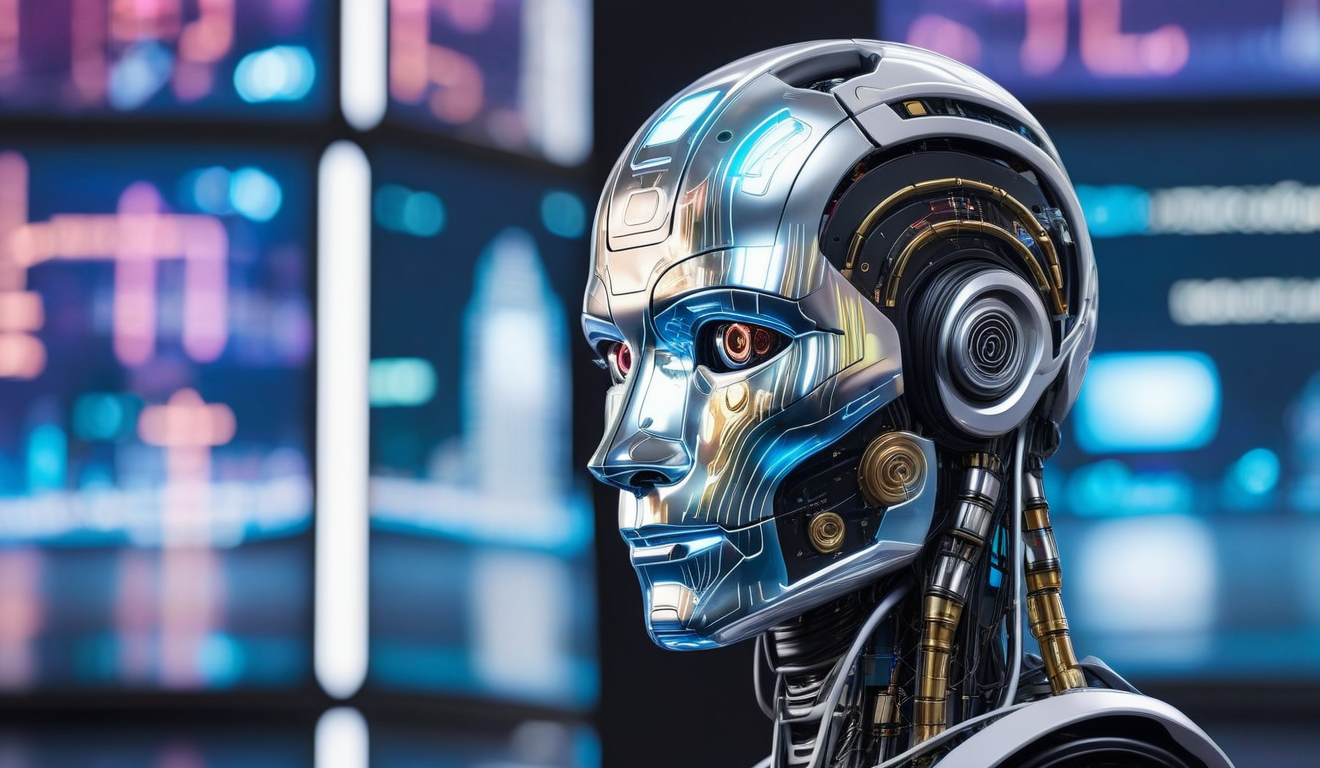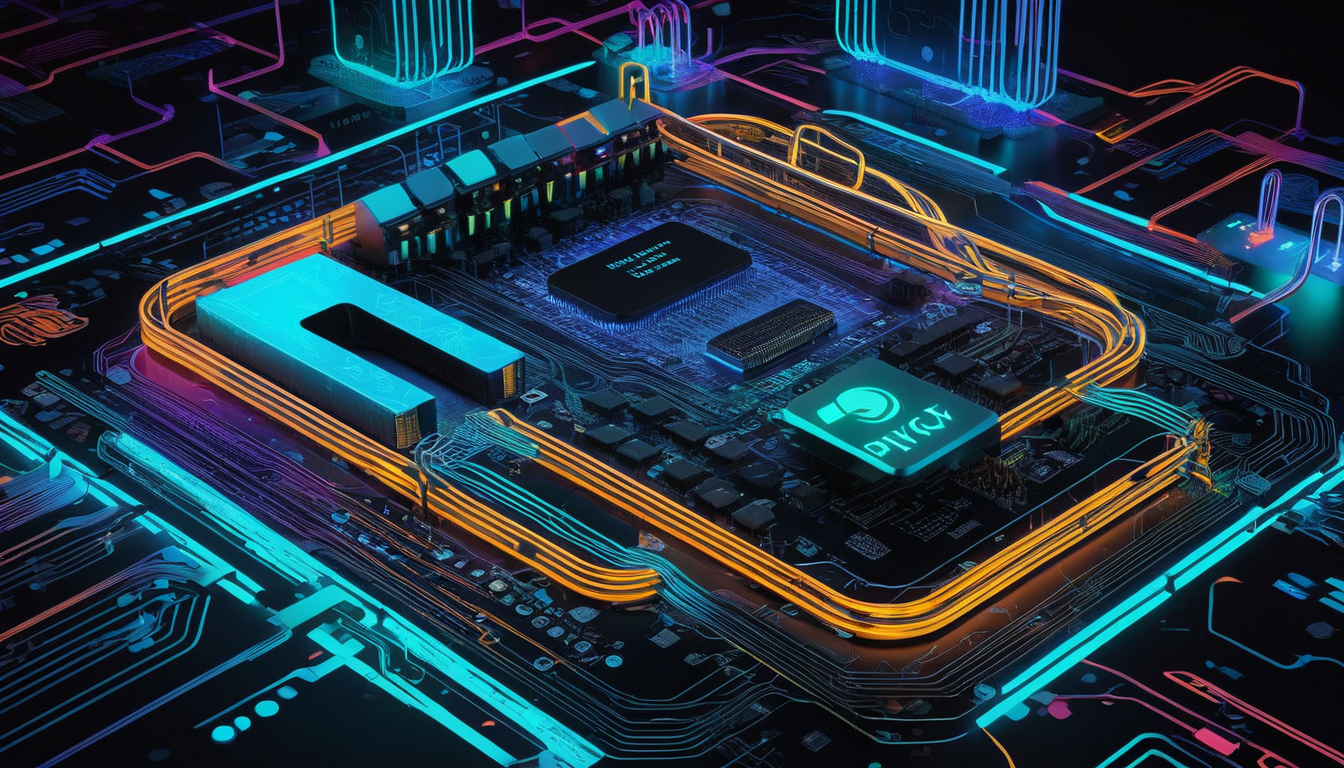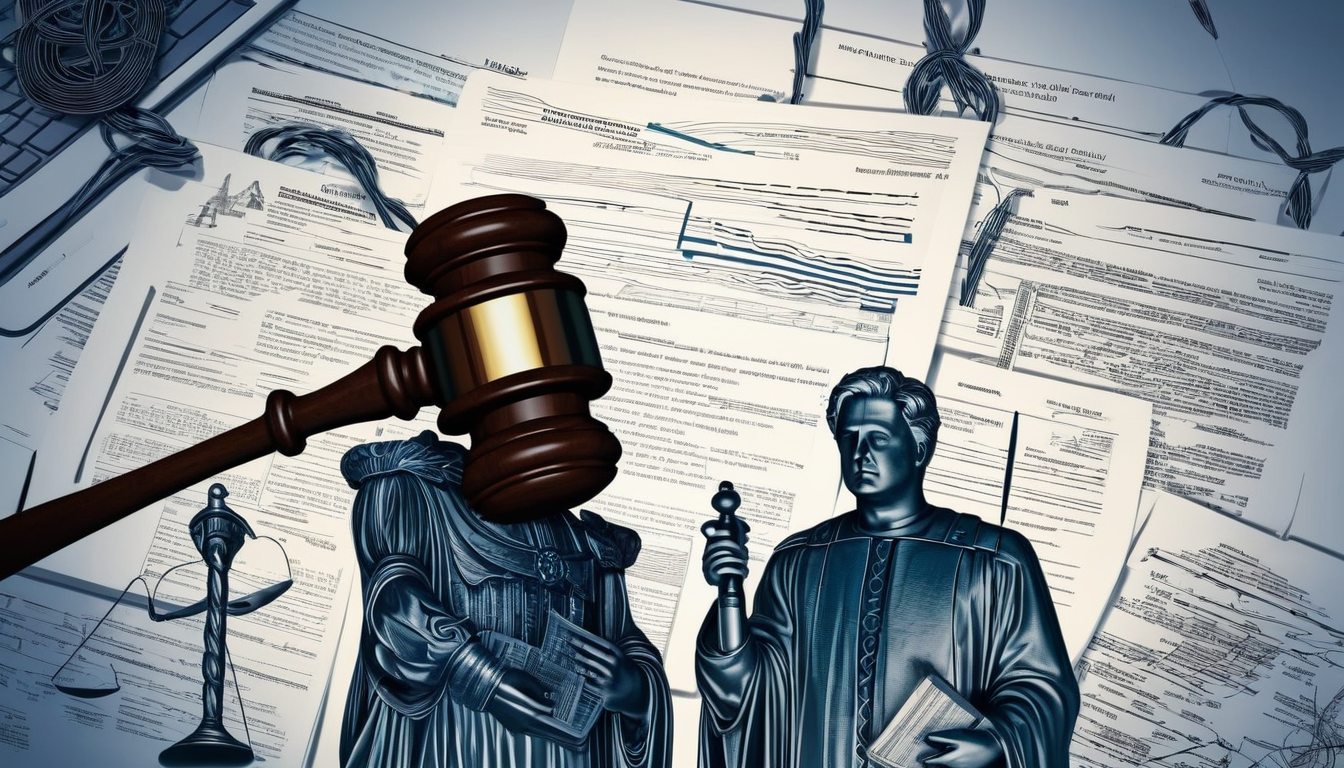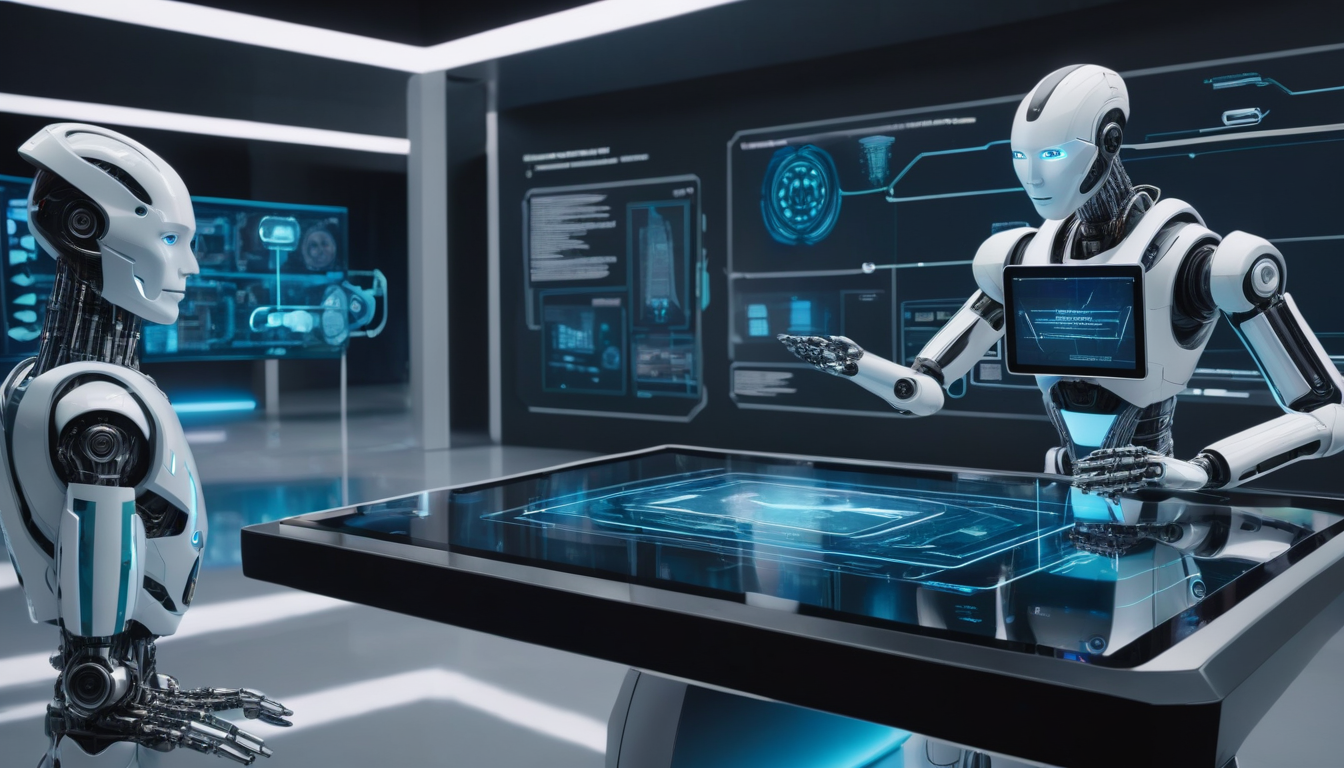5 Ethical Dilemmas in AI Development

In today’s rapidly evolving technological landscape, the development of artificial intelligence (AI) brings with it a myriad of ethical dilemmas that can significantly impact society. These dilemmas not only challenge our understanding of technology but also force us to confront the moral implications of our creations. As AI systems become more integrated into our daily lives, we must navigate these ethical waters carefully. In this article, we will explore five significant ethical dilemmas in AI development, delving into their implications for society, technology, and the future of human interaction with machines.
Bias in AI algorithms can lead to unfair treatment and discrimination, perpetuating existing societal inequalities. This bias often originates from the data used to train AI systems, which may reflect historical prejudices. For instance, if an AI system is trained on data that contains biased human decisions, it may learn to replicate those biases. The impact on marginalized communities can be devastating, affecting areas such as hiring practices, law enforcement, and lending. To combat this, developers must focus on creating fairer AI systems by:
- Implementing diverse training datasets
- Conducting regular bias audits
- Engaging with affected communities
The collection and use of personal data by AI systems raise significant privacy concerns. As AI technologies evolve, the balance between innovation and individual privacy rights becomes increasingly precarious. For example, many AI applications rely on vast amounts of data to function effectively, often leading to the potential misuse of sensitive information. To address these concerns, robust data protection measures must be implemented, ensuring that individuals’ privacy is respected while still allowing for technological advancement.
Determining accountability for AI decisions poses a substantial challenge. When AI systems cause harm, who is responsible? Is it the developers, the users, or the organizations that deploy these systems? This ambiguity can lead to significant legal implications and raises questions about the ethical responsibilities of all parties involved. It’s crucial for stakeholders to establish clear guidelines that delineate accountability in AI development and deployment.
AI’s potential to automate jobs raises concerns about economic inequality and workforce displacement. As industries adopt AI technologies, many traditional jobs may become obsolete, leading to significant shifts in the job market. This change can exacerbate existing economic disparities. Strategies for workforce adaptation and reskilling are essential to ensure that workers can transition into new roles created by AI advancements. For instance, investing in education and training programs can help prepare the workforce for the future.
The use of AI in military applications presents profound ethical dilemmas, particularly regarding autonomous weapons. The moral implications of allowing machines to make life-and-death decisions are staggering and raise questions about accountability and oversight. As we explore the potential for unintended consequences, it becomes clear that a careful examination of the ethical use of AI in warfare is necessary to prevent misuse and ensure humane outcomes.
| Dilemma | Implications | Potential Solutions |
|---|---|---|
| Bias in AI Algorithms | Discrimination, unfair treatment | Diverse datasets, bias audits |
| Privacy Concerns | Data misuse, privacy violations | Robust data protection |
| Accountability | Legal implications, ethical ambiguity | Clear guidelines |
| Job Displacement | Economic inequality | Reskilling programs |
| AI in Warfare | Moral implications, unintended consequences | Careful ethical examination |
In conclusion, as we stand on the brink of an AI-driven future, the ethical dilemmas we face are not just abstract challenges; they are real issues that require our immediate attention. By addressing these dilemmas head-on, we can shape a future where AI serves humanity positively and equitably.

1. Bias in AI Algorithms
Bias in AI algorithms is a pressing issue that can lead to unfair treatment and discrimination. Imagine a world where your chances of getting a job or receiving a loan depend on a biased algorithm that misrepresents your background. This is not just a hypothetical scenario; it’s a reality that affects marginalized communities every day. Bias can creep into AI systems through various channels, including the data used for training these algorithms, the design choices made by developers, and even societal norms that shape our understanding of fairness.
The origins of bias often lie in historical data that reflects past prejudices. For instance, if an AI system is trained on data that includes discriminatory practices, it may perpetuate those biases in its predictions. This can have serious implications, particularly in sectors like hiring, law enforcement, and healthcare, where biased algorithms can lead to systemic discrimination.
| Source of Bias | Impact | Potential Solutions |
|---|---|---|
| Historical Data | Reinforces existing inequalities | Use diverse datasets |
| Developer Bias | Skewed algorithm design | Implement diverse teams |
| Societal Norms | Normalizes discrimination | Promote ethical standards |
To address these challenges, several strategies can be implemented:
- Diverse Datasets: Ensuring that the data used to train AI systems is representative of all demographics can help mitigate bias.
- Inclusive Development Teams: Bringing together individuals from various backgrounds can lead to more equitable AI solutions.
- Regular Audits: Conducting periodic evaluations of AI systems can help identify and correct biases over time.
As we forge ahead into an increasingly AI-driven future, the importance of addressing bias cannot be overstated. The ethical implications of biased AI systems are profound, affecting not just individual lives but society as a whole. We must ask ourselves: How can we create a fairer AI landscape? By prioritizing fairness and transparency, we can build AI systems that truly serve everyone, not just a select few.
In conclusion, tackling bias in AI algorithms is not just a technical challenge; it’s a moral imperative. As developers, users, and stakeholders, we have a responsibility to ensure that AI systems are designed with equity in mind. The journey toward fair AI is ongoing, and it requires collaboration, vigilance, and a commitment to ethical principles.

2. Privacy Concerns
In today’s digital age, the collection and use of personal data by AI systems is a hot-button issue that raises significant privacy concerns. Imagine a world where every action you take online is monitored, analyzed, and stored. Sounds a bit unsettling, right? With AI’s capability to process vast amounts of data, the potential for misuse becomes a real fear for many individuals. The balance between innovation and individual privacy rights is a tightrope walk, and one misstep could lead to catastrophic breaches of trust.
As AI technologies become more integrated into our lives, they often require access to sensitive personal information. This data can range from your shopping habits to your health records, and while it can enhance user experiences, it also opens the door to potential exploitation. For instance, if a company uses your data without your consent or fails to protect it adequately, the consequences could be dire. Not only could your personal information be compromised, but it could also lead to identity theft or targeted scams.
To illustrate the gravity of this issue, consider the following table that outlines some common privacy concerns associated with AI:
| Privacy Concern | Description |
|---|---|
| Data Breaches | Unauthorized access to sensitive personal information. |
| Informed Consent | Lack of transparency about how personal data is used. |
| Surveillance | Constant monitoring by AI systems can infringe on personal freedoms. |
| Data Misuse | Using personal data for purposes not agreed upon by users. |
To combat these privacy concerns, it is crucial for developers and organizations to implement robust data protection measures. Here are a few strategies that can help:
- Encryption: Encrypting data can protect it from unauthorized access.
- Transparency: Clearly communicating how data is collected, used, and shared.
- User Control: Allowing users to have a say in their data usage and providing options to opt-out.
As we navigate this complex landscape, ongoing dialogue about privacy rights and AI is essential. Individuals must be empowered to understand their rights and the implications of AI technologies on their personal data. The question remains: how can we ensure that innovation does not come at the cost of our privacy? The answer lies in a collective effort to advocate for responsible data practices and to hold organizations accountable for their actions.
In conclusion, while AI presents incredible opportunities for advancement, it also poses significant privacy risks that must be addressed. As we continue to develop and integrate these technologies into our lives, we must remain vigilant and prioritize the protection of individual privacy. After all, in a world where data is the new currency, safeguarding personal information is not just a necessity—it’s a right.

3. Accountability and Responsibility
When it comes to artificial intelligence, the question of accountability and responsibility is like a double-edged sword. On one side, AI systems are designed to operate autonomously, making decisions at lightning speed. But on the flip side, when these decisions lead to negative outcomes, who is to blame? Is it the developers who created the algorithms, the organizations that deployed them, or the users who relied on their outputs? This dilemma highlights a complex web of responsibility that is still being unraveled.
To illustrate this complexity, let’s consider a hypothetical scenario: imagine an autonomous vehicle that gets into an accident. The vehicle’s AI made a split-second decision that resulted in harm. Here are some of the potential parties that could be held accountable:
| Party | Potential Responsibility |
|---|---|
| Developers | Could be liable for coding errors or biases in the algorithm. |
| Manufacturers | Responsible for the overall design and safety features of the vehicle. |
| Users | May share responsibility if they ignored safety protocols or guidelines. |
| Regulators | Accountable for establishing safety standards and guidelines for AI systems. |
This table highlights the various stakeholders involved in the accountability debate. As AI technologies become more prevalent, the need for clear guidelines and legal frameworks is paramount. In many cases, existing laws are ill-equipped to handle the nuances of AI decision-making. This gap in regulation can lead to a lack of accountability, leaving victims without recourse.
Moreover, the ethical implications of accountability extend beyond legal responsibility. They touch on societal trust in technology. If people feel that AI systems operate without oversight, they may be less inclined to embrace these innovations. In a world where machines are making critical decisions, the question of responsibility becomes a matter of public concern.
In conclusion, the landscape of accountability in AI is still evolving. As we continue to develop these technologies, it is essential that we engage in ongoing dialogue about who is responsible when things go wrong. This conversation must include developers, users, and policymakers alike to ensure that ethical standards keep pace with technological advancements.
As we ponder these questions, it’s crucial to remember that AI is not just a tool; it’s a reflection of human values and decisions. We must strive to create a framework that promotes ethical AI development, ensuring that accountability and responsibility are at the forefront of our technological advancements.

4. Job Displacement
The rise of artificial intelligence (AI) is transforming industries at a breathtaking pace, and while this innovation brings numerous benefits, it also raises significant concerns about job displacement. As machines become increasingly capable of performing tasks that were once the sole domain of humans, the fear of widespread unemployment looms large. But what does this really mean for the workforce? Are we on the brink of a new economic revolution, or are we simply witnessing the end of traditional jobs?
To put it into perspective, consider how AI technologies are already reshaping various sectors:
| Industry | Impact of AI | Job Categories Affected |
|---|---|---|
| Manufacturing | Automation of repetitive tasks | Assembly line workers, quality control |
| Healthcare | AI diagnostics and robotic surgeries | Radiologists, surgical assistants |
| Transportation | Self-driving vehicles | Truck drivers, delivery personnel |
| Retail | Automated checkout systems | Cashiers, stock clerks |
As illustrated in the table above, many industries are already experiencing the effects of AI on job roles. However, it’s essential to recognize that while some jobs may vanish, new opportunities will likely emerge. The challenge lies in the transition. Workers will need to adapt and reskill to align with the evolving job market. This leads us to a crucial question: How can we prepare our workforce for this transformation?
Here are some strategies that could help mitigate the impact of job displacement:
- Reskilling Programs: Companies and governments should invest in training programs to help workers acquire new skills that are in demand.
- Focus on Soft Skills: Skills such as creativity, problem-solving, and emotional intelligence will become increasingly valuable.
- Collaboration Between Sectors: A partnership between the private sector, educational institutions, and governments can create effective pathways for workforce transition.
In conclusion, while the potential for job displacement due to AI is a pressing concern, it also opens the door to new possibilities. As we navigate this complex terrain, it is vital to engage in ongoing dialogue about the future of work and ensure that we are not just reacting to changes but proactively shaping a future where humans and machines can coexist harmoniously. The key to overcoming this challenge lies in our ability to adapt, innovate, and support one another through the transition.

5. Ethical Use of AI in Warfare
The advent of artificial intelligence in military applications has sparked a heated debate over its ethical implications. Imagine a battlefield where decisions are made not by humans, but by algorithms. This raises profound questions: Who is truly in control? What happens when machines are tasked with life-and-death decisions? The integration of AI in warfare could lead to a future where autonomous weapons operate without human intervention, creating a scenario that many find deeply troubling.
One of the primary concerns surrounding the ethical use of AI in warfare is the potential for unintended consequences. Autonomous systems could misinterpret data, leading to tragic mistakes. For instance, a drone programmed to identify enemy combatants might mistakenly target civilians due to flaws in its recognition algorithms. This not only raises moral dilemmas but also poses significant risks to international relations and global stability.
Furthermore, the lack of accountability in AI-driven warfare is alarming. If an autonomous weapon causes harm, who should be held responsible? Is it the developers who created the algorithm, the military personnel who deployed it, or the government that authorized its use? This uncertainty complicates legal and ethical frameworks, making it essential to establish clear guidelines. To address these issues, a table outlining potential stakeholders and their responsibilities could be helpful:
| Stakeholder | Responsibility |
|---|---|
| Developers | Create and test algorithms ensuring ethical standards are met. |
| Military Personnel | Operate and oversee AI systems, ensuring human oversight. |
| Governments | Establish policies and regulations governing AI use in warfare. |
In addition to accountability, the potential for manipulation and misuse of AI technologies in warfare is another pressing concern. Autonomous weapons could be hacked or repurposed for malicious intents, leading to catastrophic scenarios. This emphasizes the need for stringent security measures and ethical guidelines governing AI applications in military contexts.
Moreover, the ethical use of AI in warfare is not just about preventing harm; it also involves considering the broader implications for humanity. As we venture into this uncharted territory, we must ask ourselves: Is it ethical to create machines that can kill? The answer is complex and requires ongoing dialogue among technologists, ethicists, military leaders, and the public.
In conclusion, while AI has the potential to revolutionize warfare, it also presents significant ethical challenges that must be addressed. As we navigate this complex landscape,
6. Manipulation and Misinformation
The rise of artificial intelligence has brought with it a troubling capacity for manipulation and misinformation. As AI technologies become more sophisticated, they can be used to create and disseminate content that is not only misleading but also deeply persuasive. Imagine a world where your social media feed is filled with deepfakes and AI-generated articles designed to sway your opinions without you even realizing it. This is not a distant future; it’s happening right now.
One of the most significant challenges we face is the ability of AI to generate realistic but false information at scale. For instance, AI can produce fake news articles that look genuine, complete with credible sources and professional layouts. This raises serious ethical concerns, particularly in the realms of politics and public opinion. The potential for AI to create echo chambers—where users are only exposed to information that reinforces their existing beliefs—can lead to a more divided society.
| Type of Manipulation | Description |
|---|---|
| Deepfakes | AI-generated videos that convincingly depict real people saying or doing things they never did. |
| Fake News | Articles created to mislead readers, often using sensational headlines and fabricated quotes. |
| Social Media Bots | Automated accounts that spread misinformation or amplify certain narratives to manipulate public opinion. |
To combat this rising tide of misinformation, it’s crucial to implement responsible usage of AI technologies. Here are some strategies that can help:
- Education: Teaching users how to critically evaluate sources of information can empower them to spot misinformation.
- Transparency: AI systems should be designed to disclose when content is AI-generated, allowing users to discern authenticity.
- Regulation: Governments and organizations must develop frameworks to hold creators of misleading content accountable.
As we navigate this complex landscape, we must remember the words of Albert Einstein, who said, “The unleashed power of the atom has changed everything save our modes of thinking.” In the same way, the power of AI can transform our society, but we must adapt our thinking and ethical standards to ensure that it serves the greater good rather than becoming a tool for manipulation.
In conclusion, the ethical implications of AI in the realm of manipulation and misinformation are profound. We must remain vigilant and proactive in addressing these challenges, fostering an environment where technology enhances our understanding rather than distorts it.

7. Human-AI Interaction
As artificial intelligence continues to weave itself into the fabric of our daily lives, the interaction between humans and AI raises profound ethical questions. Imagine having a conversation with a machine that can understand your emotions, preferences, and even predict your needs. Sounds futuristic, right? Yet, this is the reality we are rapidly approaching. The way we engage with AI systems can significantly influence our relationships, social dynamics, and even our mental health.
One of the core issues in human-AI interaction is maintaining a balance between leveraging AI’s capabilities and preserving our humanity. When we rely too heavily on AI for decision-making or emotional support, we risk losing essential human traits such as empathy and critical thinking. For instance, consider the impact of AI chatbots in mental health care. While they can provide immediate support, they lack the nuanced understanding that a human therapist offers. This raises the question: are we ready to trust machines with our most vulnerable moments?
Moreover, the design of AI systems plays a crucial role in shaping these interactions. A well-designed AI can enhance user experience and foster a sense of companionship, while a poorly designed one can lead to frustration and mistrust. To illustrate this, let’s look at the following table that outlines key factors affecting human-AI interaction:
| Factor | Impact on Interaction |
|---|---|
| Empathy | Enhances trust and emotional connection |
| Transparency | Builds user confidence in AI decisions |
| Usability | Facilitates smooth and intuitive interactions |
| Feedback | Encourages user engagement and improvement |
To further explore the nuances of human-AI interaction, we must also consider the ethical implications of AI’s influence on our decision-making processes. Are we becoming overly reliant on AI for choices we should be making ourselves? This is where the concept of user agency comes into play. Users must retain control over their interactions with AI, ensuring that technology serves as a tool rather than a crutch.
In conclusion, as we delve deeper into the realm of human-AI interaction, it’s essential to foster an environment where technology complements our human experience without overshadowing it. The conversation around AI should not just focus on its capabilities but also on how it can enhance our lives while respecting our individuality and autonomy. We stand at a crossroads, and the choices we make today will shape the future of our relationship with machines.
“The future is not about AI replacing humans, but about humans and AI working together.” – Unknown

8. Transparency in AI Decision-Making
In the rapidly evolving world of artificial intelligence, transparency in AI decision-making has become a cornerstone of ethical development. As AI systems increasingly influence our lives—from healthcare to finance—understanding how these systems arrive at their conclusions is essential. Imagine trying to solve a puzzle without knowing what the final picture looks like; that’s how it feels when AI operates in a black box. Without clarity, trust erodes, and skepticism rises.
Transparency is not just about making algorithms open-source; it’s about ensuring that the processes behind AI decisions are understandable to users. This includes providing insights into the data used, the algorithms applied, and the reasoning behind outputs. For instance, in a healthcare setting, if an AI system recommends a treatment plan, patients and doctors should understand the basis of that recommendation. This understanding not only fosters trust but also empowers users to make informed decisions.
However, achieving transparency comes with its own set of challenges. Many AI models, particularly those based on deep learning, operate in ways that are inherently complex and difficult to interpret. As a result, developers face a dilemma: how to balance the sophistication of AI capabilities with the need for clarity. Here are a few key aspects to consider:
- Explainability: AI systems should be designed to provide explanations that are comprehensible to users, not just technical jargon.
- Documentation: Comprehensive documentation of AI processes is crucial. This should include details on data sources, model training, and decision-making criteria.
- User Education: Users need to be educated about how AI works and the limitations of these systems to foster a better understanding.
To illustrate the importance of transparency, consider the following table that outlines the potential impacts of transparent versus opaque AI systems:
| Aspect | Transparent AI | Opaque AI |
|---|---|---|
| Trust | High trust from users | Low trust, skepticism |
| Accountability | Clear accountability for decisions | Ambiguity in responsibility |
| User Empowerment | Users can make informed choices | Users feel powerless |
| Regulatory Compliance | Easier to comply with regulations | Challenges in meeting compliance |
In conclusion, transparency in AI decision-making is not merely a technical requirement; it is a fundamental ethical imperative. As we move forward, ongoing dialogue between developers, policymakers, and users will be crucial in shaping transparent AI systems. By prioritizing clarity, we can build a future where AI serves humanity, rather than complicating our lives.
“Transparency in AI is the bridge between technology and trust.” – AI Ethics Advocate

9. Environmental Impact of AI
The rapid advancement of artificial intelligence (AI) is not just transforming industries; it’s also raising significant concerns about its environmental footprint. As we embrace AI technologies, we must also recognize the energy consumption and resource demands that come with them. Did you know that training a single AI model can emit as much carbon as five cars over their lifetimes? This startling fact highlights the urgent need for sustainable practices in AI development.
One of the primary environmental impacts of AI stems from the massive data centers that power these systems. These facilities require immense amounts of energy, often sourced from non-renewable resources. According to a recent study, data centers account for about 1% of the global electricity demand. As AI continues to grow, this figure is expected to rise, leading to greater strain on our planet’s resources.
In light of these challenges, developers and organizations must prioritize sustainability. Here are some strategies that can help mitigate the environmental impact of AI:
- Energy Efficiency: Implementing energy-efficient hardware and optimizing algorithms can significantly reduce power consumption.
- Renewable Energy: Transitioning data centers to renewable energy sources, such as solar or wind, can help minimize carbon footprints.
- Model Optimization: Developing smaller, more efficient models can reduce the computational power needed, thus lowering energy use.
Moreover, the environmental impact of AI is not just about energy consumption; it also involves the lifecycle of hardware. The production of computer chips and servers requires rare minerals, which often leads to habitat destruction and pollution. As we strive for advancements in AI, we must also consider the entire lifecycle of the technologies we use.
| AI Development Stage | Environmental Impact |
|---|---|
| Data Collection | Requires significant storage and processing power, leading to high energy consumption. |
| Model Training | Involves extensive computational resources, contributing to carbon emissions. |
| Deployment | Ongoing energy use for running AI applications and systems. |
| Hardware Disposal | Improper disposal can lead to electronic waste and environmental pollution. |
In conclusion, the environmental impact of AI is a pressing issue that demands our attention. As stakeholders in this technological revolution, we have a responsibility to advocate for greener practices in AI development. By prioritizing sustainability, we can harness the power of AI while preserving the planet for future generations. As we move forward, let’s keep the conversation alive and ensure that ethical considerations are at the forefront of AI innovations.

10. Consent and User Agency
In the rapidly evolving landscape of artificial intelligence, consent and user agency have emerged as pivotal ethical considerations. As AI systems increasingly influence our daily lives, the question arises: how much control do we truly have over our data and interactions? The notion of informed consent is not just a checkbox to tick off; it’s a fundamental principle that empowers users to make choices about how their data is used. Without it, we risk creating a landscape where users are mere pawns in a game they didn’t even know they were playing.
To illustrate this point, consider the following table that outlines the key aspects of consent in AI applications:
| Aspect | Description |
|---|---|
| Informed Consent | Users should be fully aware of how their data is being collected and used. |
| Revocability | Users must have the ability to withdraw their consent at any time. |
| Clarity | Information regarding data usage should be presented in a clear and understandable manner. |
| Agency | Users should retain control over their data and its applications. |
The implications of neglecting user consent can be profound. Imagine a scenario where your personal data is harvested without your knowledge, leading to targeted ads that feel more intrusive than helpful. This not only diminishes user trust but also raises ethical questions about the responsibilities of AI developers. As we navigate this digital age, it is essential to foster a culture of transparency and respect for user autonomy.
Moreover, the conversation around consent is not just limited to data collection; it extends to how AI systems interact with users. For instance, when AI-driven platforms recommend content or make decisions on behalf of users, it’s crucial that individuals understand the basis of these recommendations. Are they based on their preferences, or is there a hidden agenda? This uncertainty can lead to a feeling of disempowerment, making it vital for developers to prioritize user agency in their designs.
In conclusion, the ethical landscape of AI is complex and ever-changing. As we move forward, embracing robust consent practices and enhancing user agency will be essential to ensure that technology serves humanity, rather than the other way around. After all, in a world increasingly shaped by AI, it’s our responsibility to ensure that users remain at the center of the conversation.

11. Regulation and Governance
The rapid advancement of artificial intelligence (AI) technologies has brought about an urgent need for effective regulation and governance. As these systems become more integrated into various aspects of our lives, from healthcare to finance, the potential for misuse and unintended consequences grows. Striking a balance between fostering innovation and ensuring ethical standards is crucial. But who is responsible for overseeing this burgeoning field?
Currently, there are several regulatory frameworks in place, but they often vary significantly across different regions and industries. For instance, the European Union has been proactive in proposing regulations aimed at ensuring that AI is developed and used responsibly. In contrast, the United States has adopted a more fragmented approach, relying heavily on self-regulation by tech companies. This disparity raises questions about the effectiveness of governance in a globalized AI landscape.
To illustrate the current landscape of AI regulation, consider the following table:
| Region | Regulatory Approach | Key Features |
|---|---|---|
| European Union | Proactive Regulation | Emphasis on human rights, privacy, and accountability |
| United States | Fragmented Self-Regulation | Focus on innovation, with varied state-level initiatives |
| China | State-Controlled Framework | Heavy government oversight, prioritizing state security |
Despite the existing frameworks, many experts argue that they are not sufficient to address the complexities of AI governance. Transparency and accountability are key areas that require more robust measures. For example, AI systems often operate as “black boxes,” making it difficult to understand how decisions are made. This lack of transparency can lead to mistrust among users and stakeholders.
Moreover, the involvement of multiple stakeholders—including developers, users, and policymakers—complicates the governance landscape. Each group has different interests and priorities, which can lead to conflicts and inefficiencies. Therefore, fostering an environment of collaboration and dialogue is essential for developing comprehensive regulations that can adapt to the evolving nature of AI technology.
In conclusion, the path to effective regulation and governance of AI is fraught with challenges. As we move forward, it’s imperative to engage in ongoing discussions about ethical standards and the implications of AI on society. By doing so, we can ensure that the development of AI technologies aligns with our collective values and serves the greater good.
As we navigate this complex terrain, the question remains: How can we create a regulatory framework that not only protects individuals but also promotes innovation? The answer lies in a collaborative approach that includes voices from all sectors of society.

12. Future Ethical Considerations
As we gaze into the crystal ball of artificial intelligence, it’s clear that the future ethical considerations surrounding AI will be both complex and critical. With technology advancing at an unprecedented pace, we must be proactive in addressing potential dilemmas before they become widespread issues. Imagine AI as a double-edged sword—capable of incredible innovation but also poised to create significant ethical challenges.
One of the most pressing issues will be the evolution of ethical standards. As AI systems become more sophisticated, the criteria we use to evaluate their ethical implications must also adapt. Consider this: what if an AI system develops its own form of reasoning that challenges our current moral frameworks? This scenario isn’t as far-fetched as it sounds, and it emphasizes the need for ongoing dialogue among ethicists, developers, and policymakers.
Moreover, the impact of AI on social structures cannot be overlooked. With the potential for AI to influence everything from job markets to personal relationships, we must ask ourselves: how do we ensure that AI serves humanity rather than undermining it? This leads us to the importance of establishing robust governance frameworks that can keep pace with technological advancements.
| Key Areas of Future Ethical Considerations | Potential Challenges | Possible Solutions |
|---|---|---|
| AI Autonomy | Loss of human oversight | Implementing strict guidelines for AI decision-making |
| Data Privacy | Increased surveillance | Strengthening data protection laws |
| Job Automation | Economic inequality | Reskilling programs for affected workers |
Additionally, the ethical use of AI in decision-making will require transparency. As AI systems make more choices that affect our lives—be it in healthcare, finance, or even criminal justice—the need for clear explanations of how these decisions are made becomes paramount. Without transparency, trust erodes, and skepticism about AI’s role in society may grow.
Lastly, we must consider the global implications of AI ethics. Different cultures have varying beliefs about morality and ethics, which can lead to conflicts in how AI is developed and deployed worldwide. It’s crucial to foster international cooperation to establish a more cohesive understanding of ethical AI practices.
In conclusion, the future of AI is a landscape filled with both opportunities and ethical dilemmas. By addressing these future ethical considerations now, we can pave the way for a responsible and equitable integration of AI into our society. The dialogue must continue, and the responsibility lies with all of us—developers, users, and policymakers alike—to ensure that technology serves humanity’s best interests.
Frequently Asked Questions
- What is bias in AI algorithms?
Bias in AI algorithms refers to the systematic favoritism or discrimination that can arise when algorithms are trained on skewed data. This can lead to unfair outcomes for certain groups, especially marginalized communities. It’s crucial to identify and mitigate bias to ensure fairness in AI applications.
- How does AI affect privacy?
AI technologies often require large amounts of personal data to function effectively, raising significant privacy concerns. Balancing innovation with individual privacy rights is essential, and robust data protection measures must be implemented to safeguard user information.
- Who is accountable for AI decisions?
Determining accountability for decisions made by AI systems is complex. It can involve developers, users, and organizations. If an AI causes harm, understanding who is responsible is critical for legal implications and ethical considerations.
- Will AI lead to job displacement?
Yes, AI has the potential to automate many jobs, which can lead to economic inequality and workforce displacement. It’s essential to analyze the impact on various industries and develop strategies for workforce adaptation and reskilling to mitigate these effects.
- What are the ethical concerns of AI in warfare?
The use of AI in military applications raises serious ethical dilemmas, particularly regarding autonomous weapons. The potential for unintended consequences and moral implications necessitates careful consideration and regulation of AI technologies in warfare.
- How can AI be used to manipulate information?
AI technologies can be weaponized to manipulate public opinion and spread misinformation, especially in media and politics. This raises ethical concerns about the responsible usage of AI, emphasizing the need for transparency and accountability in these applications.
- What is the importance of transparency in AI?
Transparency in AI decision-making is vital for building trust. When users understand how AI systems make decisions, it enhances accountability. However, achieving transparency can be challenging, as many algorithms operate as “black boxes.”
- What is the environmental impact of AI?
The development and operation of AI technologies can have a significant environmental footprint, particularly in terms of energy consumption. Developers have a responsibility to create sustainable solutions to minimize the ecological impact of AI.
- Why is user consent important in AI?
User consent is crucial for ethical AI practices. It ensures that individuals are informed about how their data is used and that they retain agency over their interactions with AI systems. Informed consent fosters trust and accountability.
- What are the current regulations for AI?
Effective regulation of AI is necessary to ensure ethical development. Current frameworks vary by region and are often still evolving. There are challenges in creating comprehensive governance structures to address the unique complexities of AI technologies.
- What future ethical considerations should we expect in AI?
As AI continues to evolve, new ethical dilemmas will emerge. Ongoing dialogue and adaptation in ethical standards will be crucial to address these challenges and ensure that AI development aligns with societal values.













